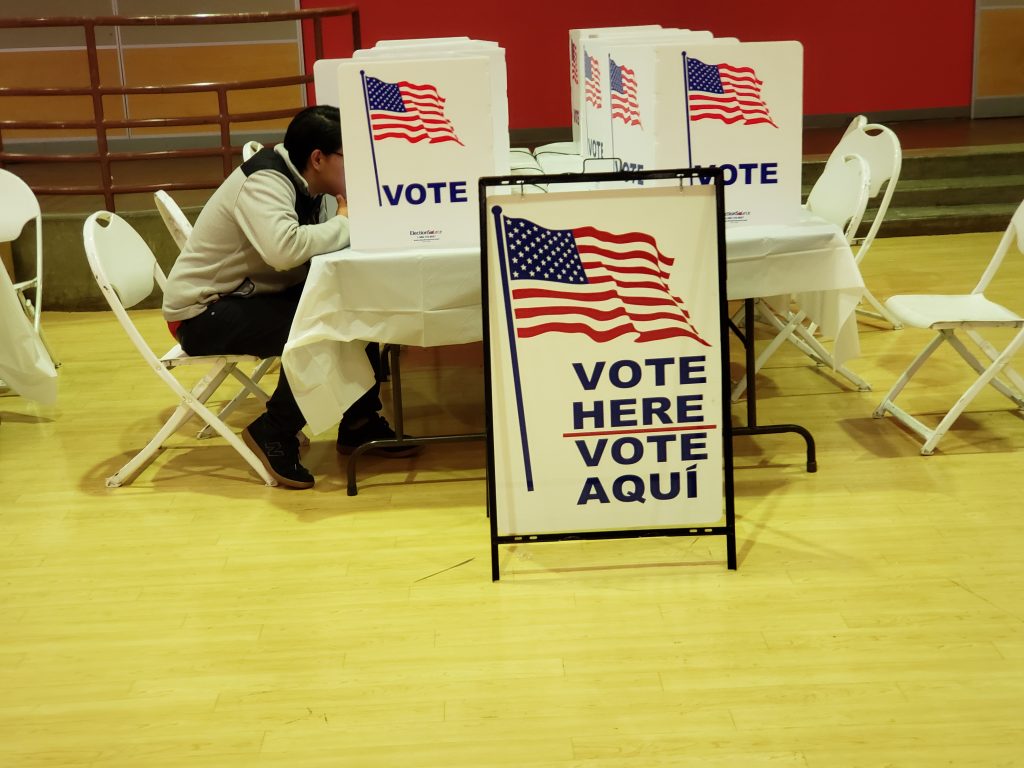Voting booth placed in the Atrium of the Academic Core Building of CUNY York College for the SGA senate elections. Photo credit: Angel Adegbesan.
By Angel Adegbesan
Student Government Association elections failed for the third time to gather enough candidates to fill the college senate. Only 30 candidates ran to fill 32 positions.
Vincent Banrey, the vice president of student development, acknowledged that 44 students picked up applications with petitions to run as senators but only 30 students brought back the proper applications signed by students.
“We advertise it to students, information is shared, then we wait,” said Banrey. “It could be students who aren’t interested or apathy. I don’t know. I do know once students are elected, they get active.”
The lack of competition raises the question as to why bother, since every candidate will be elected. David Tobo, the current Student Government Association president, said that the decision should be left to the student body of the college. He argued that voting is the students’ way of voicing their own opinions about the selected representatives.
“The rules of the university states that we have to have an election even though all 30 candidates are going to get in,” said Emmanuel Chang, the secretary of the Committee on Elections at York. “There are certain procedures that we kind of have to follow. The student representatives must be elected, so those 30 will get in and after that, there will be a special election. Hopefully we’ll be able to get another two, at least.”
In the Spring 2016 and Spring 2017 semester elections, there were 27 and 28 candidates respectively for 32 positions and special elections were held during the Fall semesters. The Committee on Elections has yet to hold a meeting to determine the exact date and process for the next special election.
Chang said the immediate priorities of students could be a probable cause for the lack of interested candidates to fill the required number of seats in the college senate. He said most students are busy with getting their college education done and may not take advantage of the opportunities, experiences and mentorship the senate may provide.
“I think a lot of students don’t recognize the benefits and influence that you can have as a senator to improve the community,” Chang said. “And also benefits for yourself. You learn leadership skills. You learn how to interact with people in positions and stations in life that are different than yours.”
Tobo said that he knows some students are excited about being empowered in the student government and causing a change. “I’ve witnessed the power of government being able to change things,” said Tobo. “At the same time, mentors have told me that not everybody will be as excited as you are about it. But, it doesn’t mean that we should take away the power of the people to vote.”
The student voter turnout for this past election was higher than some previous elections. A total number of 842 students voted in the election which accounts for 12.24 percentage of all students registered for Spring 2018 semester who are eligible to vote.
“That was a very high percentage and we have never seen anything like that,” said Randolph Punter, the dean of student development. “I understood that SGA really kind of pushed it. They were giving out water bottles. I’m assuming that these giveaways helped. To us, it was very important in these events that we set up to get students to come out. And whenever we gave things like giveaways, students will show up.”
In the York College Senate, there is an equal number of 32 student senators to 32 faculty senators. There are 17 senatorial positions slated for the 17 departments while the remaining 15 are left for Senators-at-Large.
The number of positions available for Senators-at-Large increases when departments do not have students running as their representatives. In this election, there are three and 27 candidates running as Departmental Senators and Senators-At-Large respectively.
The Student Government elects one of its members to serve as the head of the student caucus. The student caucus is comprised of all the student representatives elected to the College Senate. The College Senate has established the following standing committees that are monitored by and reported to the Senate: Committee on Academic Standards, Committee on Elections, Committee on Admissions, Committee on Instruction, Committee on Campus Environment, Committee on Library and Curriculum Committee.
Students do not have to be members of the Senate to serve on standing committees. Standing committees, including student members have full voting right privileges. The committee structure provides an opportunity for students to participate in the decision-making process.


